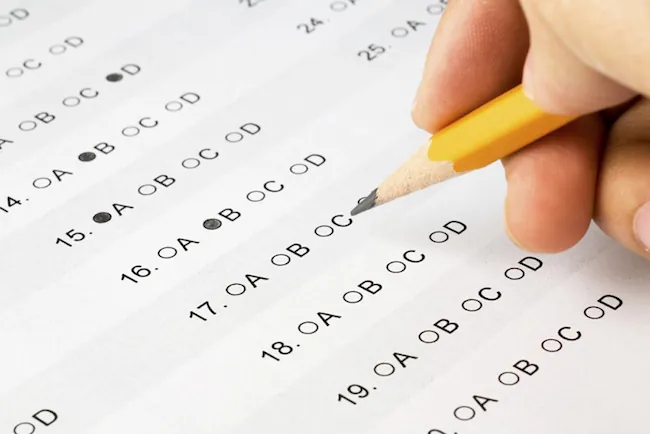
Flickr photo
Colleges that don’t require the SAT or ACT for admission enroll a higher proportion of low-income, first-generation students, and students from more diverse backgrounds, a new study says. Produced by the National Association for College Admission Counseling (NACAC), the study found that roughly two-thirds of colleges using “Test Optional Policies” saw an increase in enrollment of students “underrepresented in college populations,” or underrepresented U.S. minorities (URM).
“The number of colleges using Test Optional Policies (TOPs) in higher education admissions has dramatically expanded in recent years,” the study reads. “And these colleges have avoided ‘one-size-fits-all,’ finding varied ways to administer TOPs and experiencing varied outcomes. Much of the momentum around Test-Optional admission is focused on whether the use of standardized tests (specifically SAT and ACT) unnecessarily truncates the admission of otherwise well-qualified students.”
NEARLY ONE MILLION APPLICANT RECORDS INCLUDED
The NACAC collected student-record level data from 28 institutions including long-time users of TOP and institutions that have recently adopted the policies. These schools’ undergraduate enrollments ranged from 1,500 to 20,000 students and 15% to 90% in admission rates. In total, the study represents a dataset of 955,774 individual applicant records. The study specifically focused on underrepresented college populations in America’s universities.
“A TOP was described by many of the admission deans of the participating institutions as a tool they employed in the hope of increasing applications from a more diverse range of students, so this report focuses great attention on traditionally under-represented populations in American higher education,” the study reads. “To do so, we used our record-level data to identify the intersectionality of these underserved populations: First-Generation College Bound, students from lower SES backgrounds (Pell recipients as proxy), and students from racial and ethnic groups that have traditionally been underrepresented in college populations (URM).”
HIGH SCHOOL GPA IS A STRONGER PREDICTOR OF COLLEGE SUCCESS
One of the most striking findings of the study was that high school GPA had a stronger correlation with college success for non-submitters (students in the study who did not submit standardized test scores with their college application) than standardized tests, like the SAT and ACT.
While non-submitters had “modestly lower” high school GPAs than submitters, they ultimately graduated at rates equivalent to, or higher than, submitters.
“While test scores had a generally stronger relationship with college GPAs for the Submitters, for the Non-Submitters they tended to show a weaker relationship, essentially underpredicting the college GPA,” the study reads. “The test scores continued to most strongly correlate with family income.”
THE GROWING ‘TEST-OPTIONAL’ MOVEMENT
Over 1,000 undergraduate institutions now officially deemphasize standardized tests in admission, according to The National Center for Fair and Open Testing. Among those 1,000, over 100 additional nonprofit universities have deemphasized standardized tests in admissions in the past four years. These schools aren’t low-ranking universities either. Participating TOP adopters include schools like Bowdoin, George Washington University, and Wesleyan University.
Wesleyan University announced it would go test optional in Spring 2014. Lauren Rubenstein, the university’s manager of media & public relations tells P&Q that the experience has been positive in increasing the number of first-generation students applying.
“Research has shown that these tests can unfairly advantage some applicants, including those who can afford test prep services,” she says. “Wesleyan is committed to recruiting and enrolling students from under-served communities, students of color, and first-generation college students. Making tests optional in admissions is an important way to increase access for these students.”
Bowdoin College went test optional in 1969, becoming the first college to adopt test optional policies in admission. When the school implemented the policy, it had about 1,800 applications. Now, with TOP, it receives 9,000 applications from about 4,300 high schools around the world.
“I believe Bowdoin changed the admission process by choosing to implement a test optional policy when no other college was doing so,” Whitney Soule, dean of admissions and financial aid at Bowdoin, tells P&Q. “It was a bold move into uncharted territory for admission review and many schools have chosen to follow that same path.”
TOP has opened up higher education opportunities primarily to women, students of color, those with financial need, and those who are first generation to college, Soule says.
“The policy signals to students that we are interested in the whole student and that we are prepared to consider and assess academic preparation beyond the use of standardized tests,” she says. “As our applicant pool has grown and become more diverse over time, we have continued to honor the test-optional policy as a foundation of our commitment to holistic review.”
DON’T MISS: AVERAGE SAT SCORES AT THE TOP BUSINESS SCHOOLS or HOW TO WRITE THE NEW SAT ESSAY











Questions about this article? Email us or leave a comment below.